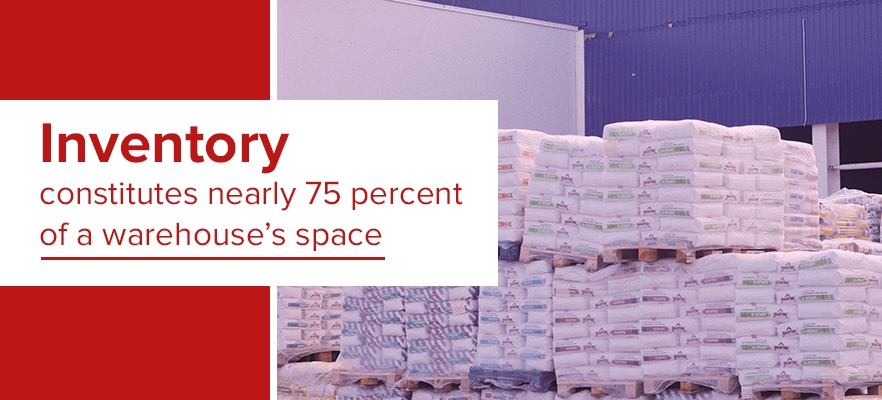Complete Guide to Warehouse Management: Chapter 6
Warehouse Inventory Management: Insider Tips and Tricks to Improve Your Overall Order Workflow
There’s no way around it — the warehouse is a key player in a business’ supply chain. Every detail that makes up how inventory gets collected, moved, stored, retrieved and shipped has the potential to help or hinder your bottom line.
While this guide has covered specific domains where warehouse operations can be streamlined, there remain broader, everyday systems and strategies with that same power. Warehouse inventory management is all about balance, aiming to complete the swiftest, most accurate lead time on orders without sacrificing employees to automation, and automation to integrity.
The following warehouse management best practices can help negotiate just that.
Improving Warehouse Order Workflow
Optimal workflow is the ultimate goal of a warehouse manager. These warehouse management best practices can directly cut down lead times during crucial order stages, better define employees’ workflow roles and ultimately increase the number of orders completed in a day.

1. Use a Single, Multi-Channel Order Processor
Gone are the days where paper reigned supreme. Warehouse orders and shipment chains of today come through multiple digital channels, both internal, company-facing networks and external, consumer-facing ones.
Warehouse managers can dramatically reduce initial order-processing lead times by converting to an omni-order processor. You get one complete digital system to receive and view orders, check inventory, initiate cross or up-sell opportunities, review timelines and send and receive order alerts. It's the sort of centralized visibility that directly streamlines your warehousing KPIs.
2. Reduce Order Idleness and Processing Cycle Times
During an order's lifecycle, if the order sits dormant and unattended in the warehouse during processing, there is room for improvement in your cycle time.
Imagine the boost in order volume and turnaround by adopting leaner processing systems that employees can get to quicker. Review solutions for shorter processing cycle times within your warehouse, from updated software to prioritized picklists to adopting a picking wave app, which gives the most efficient route for employees to retrieve items for numerous orders at once.
3. Set Processing Hours
Have a hard start and hard stop for processing orders. This is an underrated industry best practice, one that gives your employees ample time to bookend shifts with thorough clean-up and organization. Which, in turn, will reduce rates of processing errors like such as mislabeled orders or forgotten packages.
4. Employ Senior-Level Quality Control
Don’t leave quality control to the last minute. Adopt a checklist of written quality control measures that must be reviewed with all outbound shipments. Have a senior member of the team perform this function. If possible, use a multi-stage review process to check orders before retrieval, during packaging and immediately before shipment. Always stress quality over quantity, even during the busiest shipment periods. Your reputation depends on it.
5. Minimize Touchpoints
The more hands inventory must pass through, the slower your order workflow. It’s more than likely your warehouse has extraneous touches at every major designated warehouse space, from its loading docks to outbound shipment.
Conduct a movement walk-through to demonstrate how many "hands" or "stages" a typical inventory order undergoes. Take note of any middle-man steps, literal or figurative. These can include unnecessary transportation bins, messy inventory storage or too many single shipments at your loading docks.
Improving Warehouse Inventory Management
With inventory constituting nearly 75 percent of a warehouse’s space, inventory management goes beyond simple shelving configuration.

Yes, you should set up vehicle and walking personnel routes to streamline movements. Yes, you should have equipment that better moves and manages pallet racks and other warehouse necessities so your workers don’t have to. Yes, you should house high-turnover SKUs and custom kits at the front of your warehouse. Yet how else can you improve inventory management?
1. Isolate SKU Storage as Much as Possible
Workers should be able to identify and pick out SKUs within a few seconds of searching a shelf. If it takes longer than this, you may have too much inventory crammed together or too many custom kits unorganized and poorly labeled. This is a warehousing problem particularly if you use storage bins or crates.
2. Use Asset Tracking to Make More Informed Internal Orders
Your own product management can fall to the wayside if you're relying on outdated or oversaturated order tracking. Your cycle counts must, therefore, be a priority. Start by scheduling set cycle counts that divide inventory into smaller, more manageable data groups. Over time, begin dedicating resources to turn those periodic cycle counts into ongoing ones. The more you know about what sells, and when, the better you can manage it.
3. Identify Warehouse Choke Points
These will most likely occur at your shipping and receiving docks, where tricks like scheduling simultaneous inventory shipments or advanced shipping notifications still go underutilized. Coordinate processes and operational rules accordingly. Train area employees in well-defined tasks to curb these inefficiencies. Ensure you have the right balance of personnel, automated equipment and digital resources to bridge the gap between an old choke point and a new set of efficient operations.
4. Always Get Employee Feedback
The very people who deal with inventory day in and day out will likely have vital and intuitive suggestions for its organization and management. Never forget to set up channels where employees can easily submit ideas. Whether it’s traditionally scheduled meetings dedicated to ideation or an email account for written suggestions, review open-mindedly and consistently.





